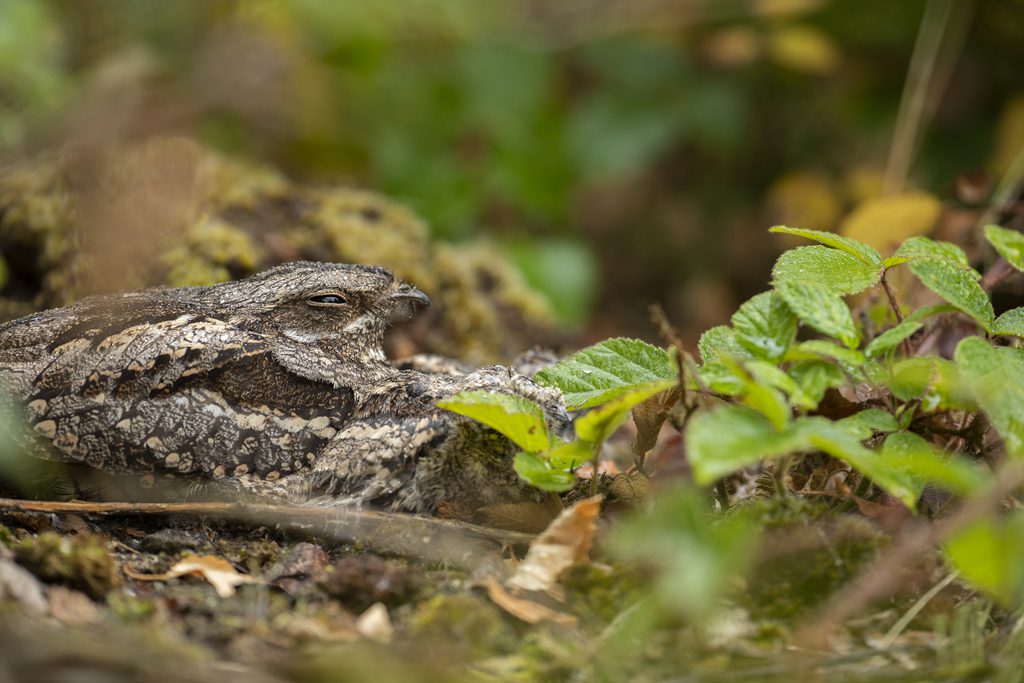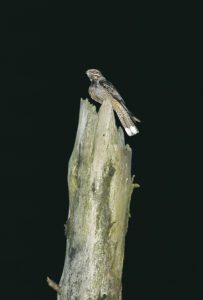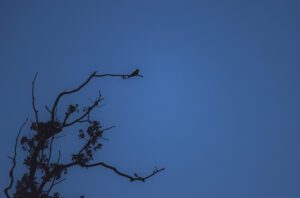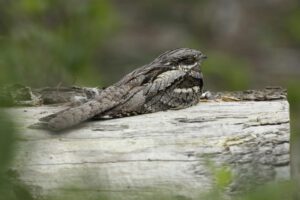Nightjar and their nests are perfectly camouflaged and typically go unnoticed. Ben Andrews (rspb-images.com).
A recent survey conducted in the southeast has successfully confirmed that one of Ireland’s rarest and most elusive birds, the nocturnal Nightjar, continues to breed in the country, though in very limited numbers.
With only sporadic records of breeding over recent decades, mostly in the south and south-east, the general consensus was that we had effectively lost Nightjars, despite few attempts to prove otherwise. However, a new survey coordinated by BirdWatch Ireland and supported by Kilkenny County Council, Wexford County Council and the National Parks and Wildlife Service through the Local Biodiversity Action Fund confirms that this species still survives in the southeast.
The mysterious and elusive Nightjar is one of our most intriguing birds. A summer visitor with perfectly camouflaged bark-like plumage, it can be incredibly difficult to spot, only revealing its presence after dark, when the male engages in it’s hypnotic ‘churring’ song.
A Male Nightjar ‘churring’ from a tree stump in the night. Photo: Mike Brown.
Nightjars were once more common and widespread in Ireland, their rising and falling song was so widely-known that the bird was given its own name, Túirne Lín, meaning spinning-wheel. However, the numbers completing the journey to Ireland from African wintering grounds each May have diminished dramatically. This is thought to be related to habitat loss and a decrease in large insects due to the use of pesticides. Nightjars feed on moths and other flying insects, and they are well equipped for this: they have very large eyes adapted for hunting in low light, and a wide-gaping mouth designed to capture insect prey in flight.
As the Nightjars ‘churring’ has faded from popular memory and from most of its former range, the species has slipped into relative obscurity, which is somehow fitting for a secretive bird adapted to disappear into its surroundings. We have mourned the declines of species such as Curlew, Hen Harrier and Ring Ouzel, but the disappearance of Nightjar has largely gone unnoticed.
The uncertainty over the status of Nightjar in Ireland set the scene for a survey undertaken this summer. The aim of the survey was to try and confirm whether Nightjar still remain in Ireland and in the process, to learn more about this enigmatic species to help inform its conservation. The Nightjar survey was coordinated by BirdWatch Ireland and concentrated on some of the most suitable remaining areas for Nightjar in Counties Kilkenny and Wexford.
Conservation Officer with BirdWatch Ireland John Lusby, who coordinated the efforts, explained how the survey was carried out: “We used acoustic recording devices which were set to record bird song in the late evening and throughout the night in areas deemed to be suitable for Nightjar, which were typically low-lying hills with forest plantation and especially recently clear-felled forest surrounded by suitable foraging habitat, in the hope that we would detect the very distinctive and unmistakable song of Nightjar, thereby confirming its presence in an area”.
Nightjar on a branch at dusk. Photo: Ben Andrews (rspb-images.com).
These survey efforts were rewarded when, within the many hundreds of hours of recordings, and among the songs and calls of many other bird species, the fabled churring of Nightjar was detected from not one but two of the survey sites. Subsequent monitoring of these sites provided confirmation that one of these pairs bred successfully, marking what appears to be the only known Nightjar successful nesting in the country.
Colin Travers, one of the lead surveyors for the Nightjar survey, commented,: “It was such an amazing privilege to listen to Nightjar ‘churring’, although I was not previously familiar with this magical song, it felt natural to be listening to it in the Irish landscape, and obviously the significance of hearing their churring cannot be overstated, as it is telling us in very simple terms that even if we have somewhat forgotten about Nightjars, they are still here”.
Although Nightjar numbers do appear to be extremely low in Ireland, there is some hope if we look to nearby Wales and other countries where conservation efforts have proved successful and where Nightjar populations are recovering. John Lusby, commented: “Now we know that Nightjar are still here, we need to do all we can to make sure we don’t lose them, which should include protecting and enhancing the nesting and foraging habitats at the sites where they are known to occur as well as other areas which have the potential to host Nightjar, hopefully this will help to ensure that birds will return to these areas next May and in future summers and expand out to other areas”.
Nightjar roosting during the day on a log. Photo: Andrew Hay (rspb-images.com).
Bernadette Moloney, Biodiversity Officer with Kilkenny County Council, who supported the Nightjar survey, commented: “It is incredibly important to understand what biodiversity we have and to protect what we have remaining. This survey served to highlight the biodiversity importance of some sites in the south-east which have otherwise not received much attention and are not part of our network of protected sites and it is wonderful to know that Nightjar still remain in these areas”.
Claire Goodwin, Biodiversity Officer with Wexford County Council said: “We were delighted to support this survey with the assistance of funding through the Local Biodiversity Action Fund and it is brilliant news to learn that there were two pairs identified, one pair breeding successfully. Whilst this is marvellous news the low numbers highlight the fragility of the species and the urgent need for protection and conservation of their habitat”.
Here is a video which showcases the survey efforts invested to find Nightjar in the south-east.





